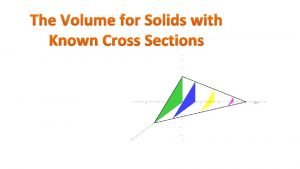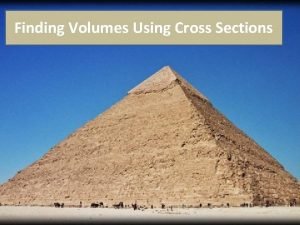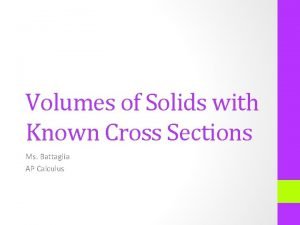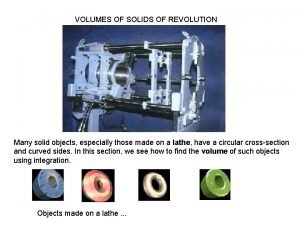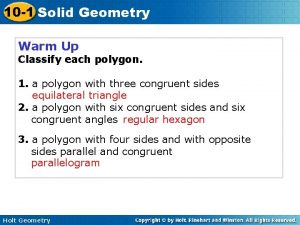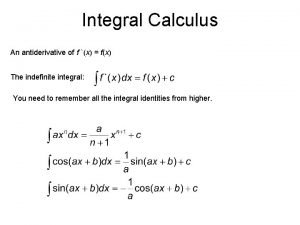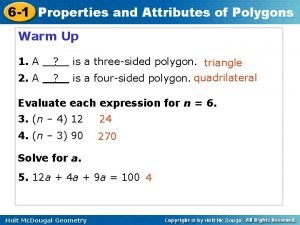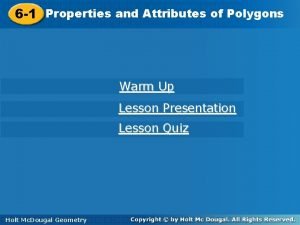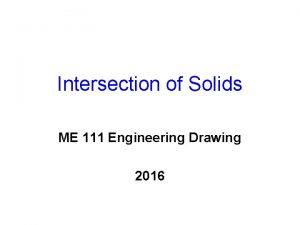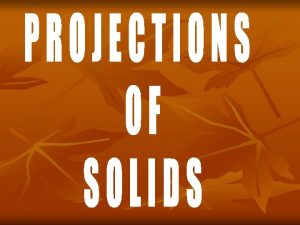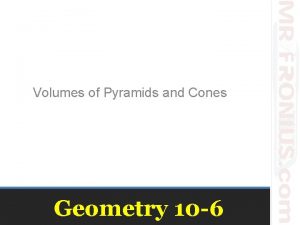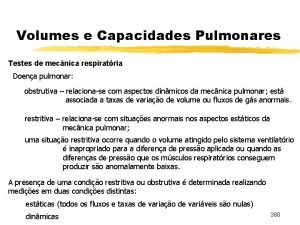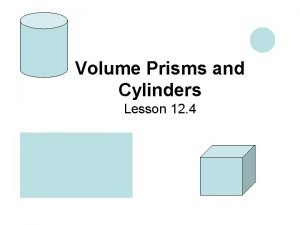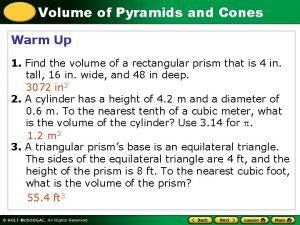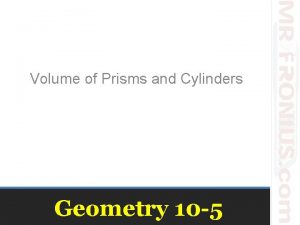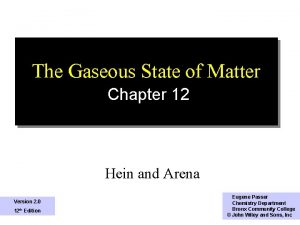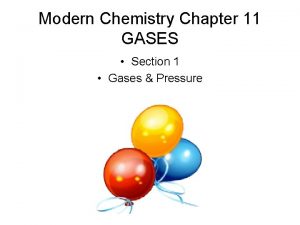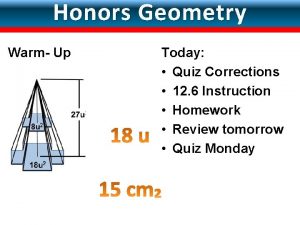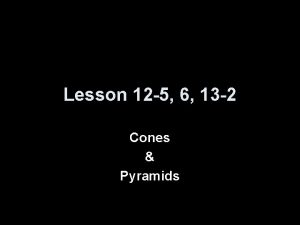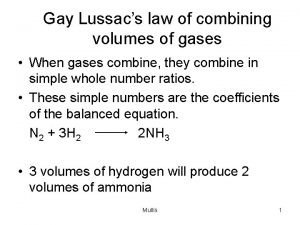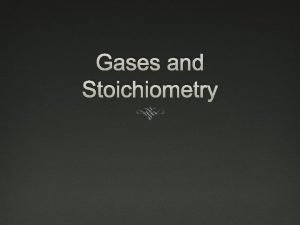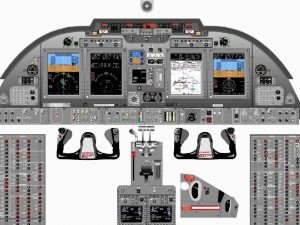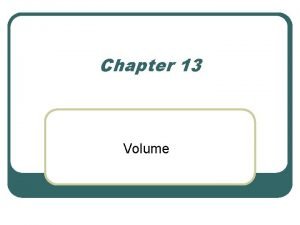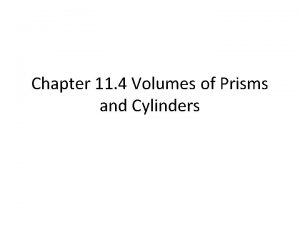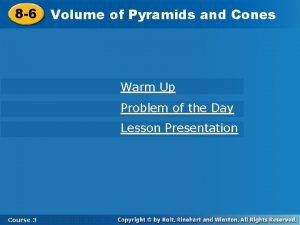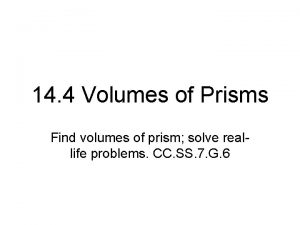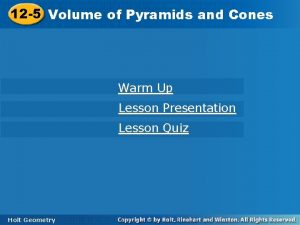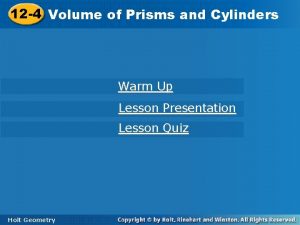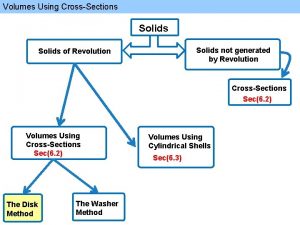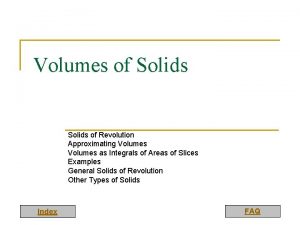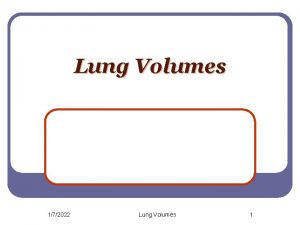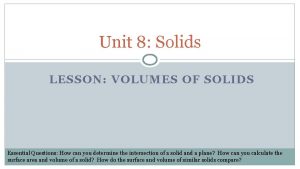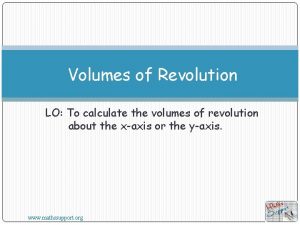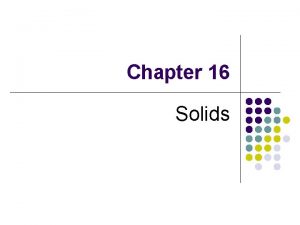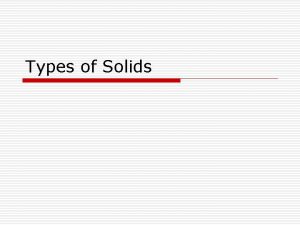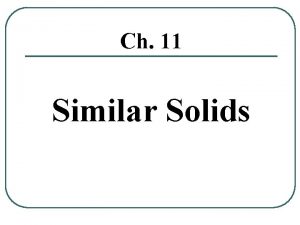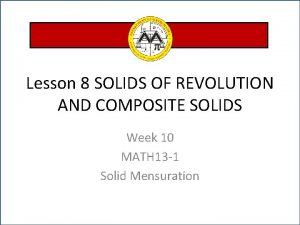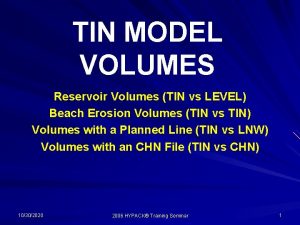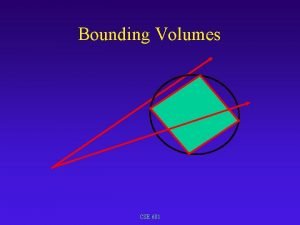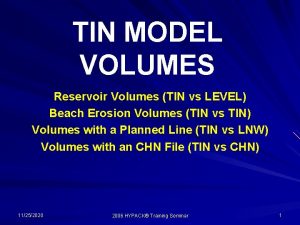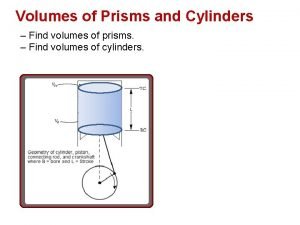Volumes Using CrossSections Solids of Revolution Examples Classify












































- Slides: 44

Volumes Using Cross-Sections Solids of Revolution Examples: Classify the solids Solids not generated by Revolution

Volumes Using Cross-Sections Solids of Revolution Solids not generated by Revolution

Volumes Using Cross-Sections Solids of Revolution Volumes Using Cross-Sections Sec(6. 1) The Disk Method The Washer Method Volumes Using Cylindrical Shells Sec(6. 2)

VOLUMES 1 The Disk Method Strip with small width generate a disk after the rotation

VOLUMES 1 The Disk Method Several disks with different radius r

VOLUMES

VOLUMES 1 step 1 Disk cross-section x Graph and Identify the region step 2 Draw a line (L) perpendicular to the rotating line at the point x step 3 Rotate this line. A circle is generated step 4 Find the radius r of the circe in terms of x step 5 step 6 Intersection point between L, curve Now the cross section Area is Specify the values of x Intersection point between L, rotating axis step 7 The volume is given by

VOLUMES

VOLUMES

Volumes Using Cross-Sections Sec(6. 1) The Disk Method The Washer Method

Volumes Using Cross-Sections Sec(6. 1) The Disk Method The Washer Method Examples: Classify

Volumes Using Cross-Sections Sec(6. 1) The Disk Method The Washer Method Examples: Classify

VOLUMES Volume = Area of the base X height

VOLUMES

VOLUMES 2 The washer Method If the cross-section is a washer , we find the inner radius and outer radius

VOLUMES 2 The washer Method Intersection point between L, boundary step 1 Graph and Identify the region step 2 Draw a line perpendicular to the rotating line at the point x step 3 Intersection point between L, boundary Rotate this line. Two circles created step 4 Find the radius r(out) r(in) of the washer in terms of x step 5 Now the cross section Area is step 6 Specify the values of x step 7 The volume is given by Intersec pt between L, rotation axis

VOLUMES T-102

VOLUMES Example: Find the volume of the solid obtained by rotating the region enclosed by the curves y=x and y=x^2 about the line y=2. Find the volume of the resulting solid.

VOLUMES 3 The Disk Method (about y-axis) If the cross-section is a disk, we find the radius of the disk (in terms of y ) and use

VOLUMES The Disk Method step 1 (about y-axis) Graph and Identify the region step 2 Draw a line (L) perpendicular to the rotating line at the point y step 3 Rotate this line. A circle is generated step 4 Find the radius r of the circe in terms of y step 5 step 6 Now the cross section Area is Specify the values of y The volume is given by step 7

VOLUMES 4 Example: The Washer Method (about y-axis or parallel) The region enclosed by the curves y=x and y=x^2 is rotated about the line x= -1. Find the volume of the resulting solid.

VOLUMES 4 washer cross-section y step 1 Graph and Identify the region step 2 Draw a line perpendicular to the rotating line at the point y step 3 Rotate this line. Two circles created step 4 Find the radius r(out) r(in) of the washer in terms of y step 5 Now the cross section Area is step 6 Specify the values of y step 7 The volume is given by

VOLUMES SUMMARY: The solids in all previous examples are all called solids of revolution because they are obtained by revolving a region about a line. solids of revolution NOTE: solids of revolution Rotated by a line parallel to x-axis ( y=c) Rotated by a line parallel to y-axis ( x=c) The cross section is perpendicular to the rotating line Cross-section is DISK Cross—section is WASHER

VOLUMES BY CYLINDRICAL SHELLS rotating line Parallel to x-axis CYLINDRICAL SHELLS (6. 2) Remarks rotating line Parallel to y-axis rotating line Parallel to x-axis Remarks Using Cross-Section(6. 1) rotating line Parallel to y-axis Cross-section is DISK Cross—section is WASHER SHELL Method

VOLUMES parallel to x-axis SHELLS Cross-Section parallel to y-axis

VOLUMES BY CYLINDRICAL SHELLS T-131 Remark: before you start solving the problem, read the choices to figure out which method you use

T-111

VOLUMES T-102

Volumes Using Cross-Sections Solids of Revolution Solids not generated by Revolution

Volumes Using Cross-Sections Example: 2 The base of a solid is bounded by the curve y = x /2 and the line y =2. If the cross-sections of the solid perpendicular to the y-axis are squares, then find the volume of the solid Base: is bounded by the curve and the line y =2 Cross-sections: If the cross-sections of the solid perpendicular to the y-axis are squares

VOLUMES Jonathan Mitchell

VOLUMES Example: The base of a solid is bounded by the curve and the line x =9. If the cross-sections of the solid perpendicular to the x-axis are semicircle, then find the volume of the solid Base: is bounded by the curve and the line x =9 Cross-sections: If the cross-sections of the solid perpendicular to the x-axis are semicircle

VOLUMES Example: The base of a solid is bounded by the curve and the line x =9. If the cross-sections of the solid perpendicular to the x-axis are semicircle, then find the volume of the solid Base: is bounded by the curve and the line x =9 Cross-sections: If the cross-sections of the solid perpendicular to the x-axis are semicircle

VOLUMES Example: The base of a solid is bounded by the curve and the line x =9. If the cross-sections of the solid perpendicular to the x-axis are semicircle, then find the volume of the solid Base: is bounded by the curve and the line x =9 Cross-sections: If the cross-sections of the solid perpendicular to the x-axis are semicircle

VOLUMES Example: The base of a solid is bounded by the curve and the line y = 0 from x=0 to x=pi. If the cross-sections of the solid perpendicular to the x-axis are equilatral triangles. Base: is bounded by the curve and the line y =0 Cross-sections: If the cross-sections of the solid perpendicular to the x-axis are semicircle

VOLUMES Example: The base of a solid is bounded by the curve and the line y = 0 from x=0 to x=pi. If the cross-sections of the solid perpendicular to the x-axis are equilatral triangles. Base: is bounded by the curve and the line y =0 Cross-sections: If the cross-sections of the solid perpendicular to the x-axis are equilatral triangles

Volumes Using Cross-Sections step 1 Example: 2 The base of a solid is bounded by the curve y = x /2 and the line y =2. If the cross-sections of the solid perpendicular to the y-axis are squares, then find the volume of the solid Cross-sections: If the cross-sections of the solid perpendicular to the y-axis are squares step 2 Graph and Identify the region ( graph with an angle) Draw a line (L) perpendicular to the x-axis (or y-axis) at the point x (or y), (as given in the problem) step 3 step 4 Find the length (S)of the segment from the two intersection points with the boundary Cross-section type: Square S = side length Semicircle S = diameter Equilatral S = side length Cross-section type: Square Semicircle Equilatral step 6 Specify the values of x The volume is given by step 7

VOLUMES Example: The base of a solid is bounded by the curve and the line x =9. If the cross-sections of the solid perpendicular to the x-axis are semicircle, then find the volume of the solid step 1 step 2 Graph and Identify the region ( graph with an angle) Draw a line (L) perpendicular to the x-axis (or y-axis) at the point x (or y), (as given in the problem) Cross-sections: If the cross-sections of the solid perpendicular to the x-axis are semicircle step 3 step 4 Find the length (S)of the segment from the two intersection points with the boundary Cross-section type: Square S = side length Semicircle S = diameter Equilatral S = side length Cross-section type: Square Semicircle Equilatral step 6 Specify the values of x The volume is given by step 7

VOLUMES T-102

VOLUMES T-122

VOLUMES T-092

VOLUMES

T-132

T-132
 How to find volume of a semi circle
How to find volume of a semi circle Volumes with known cross sections
Volumes with known cross sections Volumes of solids with known cross sections
Volumes of solids with known cross sections Volumes of solids with known cross sections calculator
Volumes of solids with known cross sections calculator Volume of disc
Volume of disc Similar
Similar 10-1 solid geometry
10-1 solid geometry Volumes of revolution
Volumes of revolution Section 14-3 human molecular genetics answer key
Section 14-3 human molecular genetics answer key Properties and attributes of polygons
Properties and attributes of polygons How do i classify polygons using their attributes
How do i classify polygons using their attributes Russian revolution vs french revolution
Russian revolution vs french revolution You should hope that this game will be over soon
You should hope that this game will be over soon Modern commercial agriculture
Modern commercial agriculture Expansion of solids liquids and gases examples
Expansion of solids liquids and gases examples Intersection of square prism and cylinder
Intersection of square prism and cylinder Examples of solids liquids and gases pictures
Examples of solids liquids and gases pictures What are the properties of solid
What are the properties of solid Projection of solids cone
Projection of solids cone Characteristics of non-flowering plants
Characteristics of non-flowering plants Practice 10-6 volumes of pyramids and cones answers
Practice 10-6 volumes of pyramids and cones answers Mecanica respiratoria
Mecanica respiratoria 12-4 volumes of prisms and cylinders
12-4 volumes of prisms and cylinders Volume of pyramids worksheet answer key
Volume of pyramids worksheet answer key What is the volume of this prism?
What is the volume of this prism? Law of combining volumes
Law of combining volumes 1 inch
1 inch Avogadro's law relationship
Avogadro's law relationship 12-6 surface areas and volumes of spheres
12-6 surface areas and volumes of spheres Lesson 12-5 volumes of pyramids and cones
Lesson 12-5 volumes of pyramids and cones 14cfr91
14cfr91 Hpe cloud volumes pricing
Hpe cloud volumes pricing Law of combining volumes
Law of combining volumes Law of combining volumes
Law of combining volumes Law of definite proportions
Law of definite proportions Fisiologia respiratória
Fisiologia respiratória Cut and fill calculations grid method
Cut and fill calculations grid method Vor block diagram
Vor block diagram Lesson 13-1 volume of cylinders answers
Lesson 13-1 volume of cylinders answers 11-4 volumes of prisms and cylinders
11-4 volumes of prisms and cylinders Im injection sites and volumes pediatrics
Im injection sites and volumes pediatrics Volume of pyramids and cones
Volume of pyramids and cones Volume of a trapezium
Volume of a trapezium 12-5 volume of pyramids and cones
12-5 volume of pyramids and cones Lesson 12-4 volumes of prisms and cylinders
Lesson 12-4 volumes of prisms and cylinders
